“They’re only original once.” How many times have we heard that line? It is true of this 1950 Chrysler Imperial that has collected a selection of show trophies courtesy of its overall condition as a genuine survivor. The seller has been its custodian since 2007 but feels the time is right for this gem to find a new home. It has no pressing needs, and I must say a big thank you to Barn Finder Tony P for spotting this fantastic classic.
There is a bit for potential buyers to consider with this 1950 Chrysler Imperial. The seller describes it as a survivor, suggesting that its Light Blue Gray paint was applied at the factory. It retains a pleasant shine, with no evidence of significant deterioration or other problems. The panels are as straight as an arrow, and there are no signs of rust that might cause sleepless nights. A close inspection reveals pimples below the surface of many plated trim pieces, although they remain presentable for those wishing to preserve this car’s survivor status. The glass is clear, and the wheel covers are excellent. So far, so good. However, there is more to consider, because this Chrysler has garnered a fair collection of awards and trophies. It received the Judge’s Choice Award at the 2009 VAE Car Show, and the “Best Original” trophy at the 2024 Shriners Car Show in Rutland, Vermont. Throw in its feature car status as the “Driveable Dream” in the November 2009 edition of Hemmings Classic Car magazine and its invitation to the 2008 Hemmings Concours D’Elegance, and you can be assured we are dealing with a pretty special vehicle.
Powering this Imperial is a 323ci straight-eight engine producing 135hp and 270 ft/lbs of torque. Power feeds to the road via a four-speed automatic transmission, with this classic also scoring power brakes. The seller is candid about its performance potential, which is defined by its curb weight of 4,430 lbs. Therefore, open road cruising is more its forte than outright acceleration. The only shortcoming identified by the seller is the age of the tires. They are over fifteen years old, and they advise that changing them soon would be wise. Otherwise, this Imperial runs and drives perfectly, with no squeaks, rattles, or other issues. Its originality is further reinforced by the presence of many of the inspection stamps and marks this gem received at the factory.
I agree with the seller’s statement that the most impressive aspect of this Imperial’s interior is the wheel. These are prone to cracking and deterioration, and locating a good replacement is virtually impossible. However, this one hasn’t suffered that fate, which would prompt me to fit a wheel wrap as ongoing protection. Most of the interior trim is original, including the carpet. This shows wear and deterioration under the driver’s feet, but mats will hide the problem if the new owner wishes to protect the Chrysler’s survivor status. It is a similar story with the armrests and parcel tray, although the seats and door trims are excellent. The dash is a work of art, as is the gauge cluster. There are no visible aftermarket additions, while the buyer can enjoy the benefits provided by power windows, a pushbutton radio, a clock, and a heater.
Finding an original survivor that presents well after more than seven decades of active service isn’t unprecedented, but cars of this caliber are always welcomed by dedicated enthusiasts. The seller has listed this 1950 Chrysler Imperial here on Craigslist in Shrewsbury, Vermont, with an asking price of $11,500. That makes it an affordable option for those searching for a serious contender to park in their garage. It is particularly tempting when you consider the list of awards it has achieved in its current form. We are often told not to yield to temptation, but that would be understandable in this case. Do you agree?
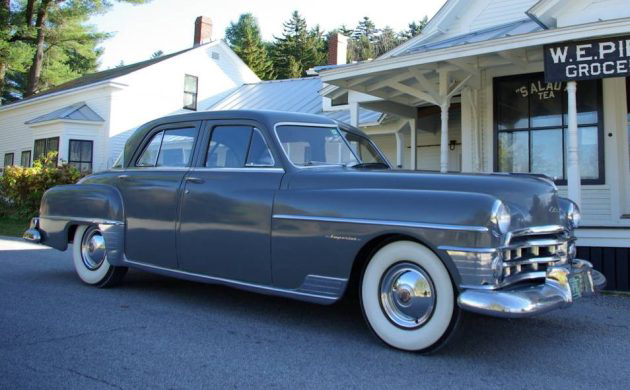
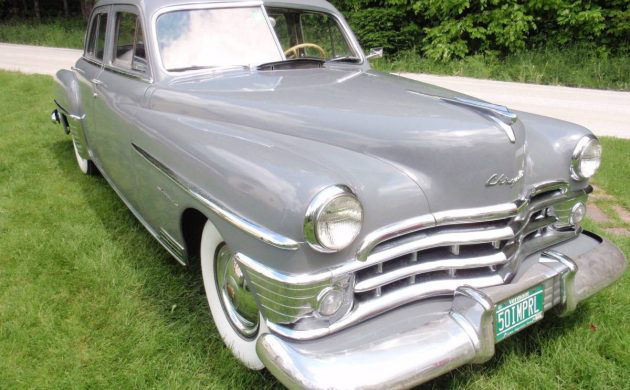
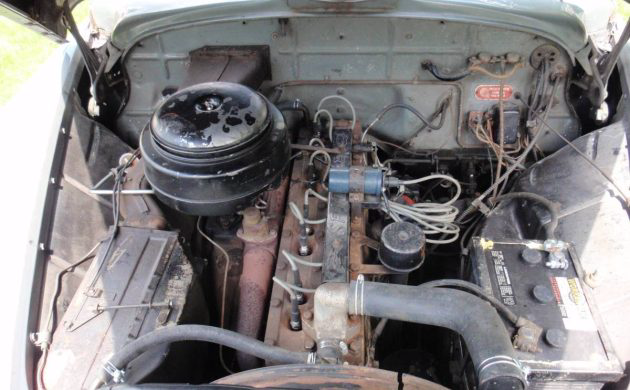
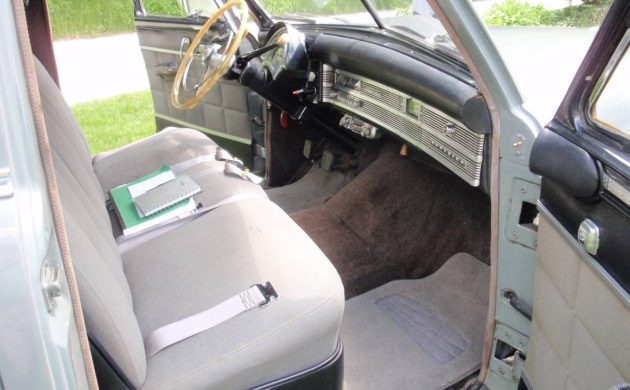
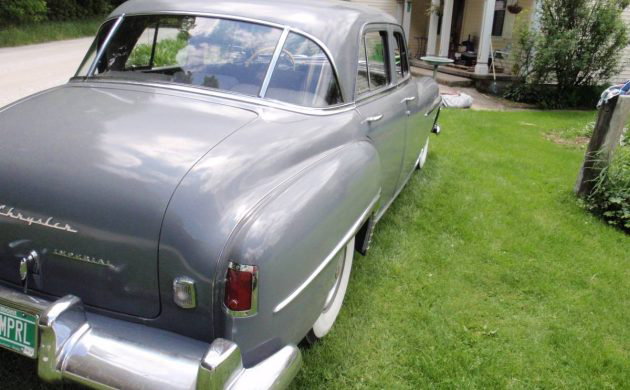


Hey, gramps, lose the whitewalls, eh? It is the 1st thing to distract a modern buyers, looks corny. Sadly, “park it ’round back”, and will be stacked 2 or 3 deep with all the others, like the Hudson. It’s easy to get frustrated, me a perfect example, of how times have changed, and our memory( and this site) is what keeps it dear to us, but we’ve gotten to the point, that cars like this don’t fit in, a stark change from 1950. In 1950, we, as a country, were doing better. Innovations were bringing people back to work that lost military jobs, and while Korea didn’t have the zing of Dubja, Dubja 2, der, it probably was the best thing for our economy. Wages almost tripled from pre-war jobs, and a Chrysler spoke volumes over a mere Ford or Chevy. It’s what successful people( or their wives after 1951 when P/S was offered) drove. Sorry ladies, while they may have gotten Imperials to drive from the hubby’s job, women still made a fraction of what men made, and had to settle for the bus. I read, this car cost almost $3600 bucks new, twice what a Ford or Chevy, but about the same as other high class cars and hampered sales with only about 20,000 sold. Like all, has about as much interest as bug repellent in winter, but were fantastic cars.
Great observations as always Howard! The subject reminds of my 1952 Imperial 4dr I drove through high school at half of college. It was well past “original” when I bought it for $500…but it was mine. It was dark green, after a 50 footer paint job, 331 Hemi, fluid torque drive, working am tube radio, 3 cigarette lighters, power windows AND pop up cowl vent for “AC”. I did purchase correct wide white walls from Sears auto center. The interior of my car appears identical to the subject car. Nice find, but potential buyers have aged out.
Sorry Howard, but for me the wide whites take this lovely car out of the ordinary and into the highly desirable bracket. I just love wide whites. I even fitted them to my Healey 3000, 1983 Ford Bantam pickup and my 1981 Mazda B1600 pickup! If they were available here in UK right now they would be installed on my 2010 Ford Focus!
HRH, Elizabeth II would not be amused by the previous post. This Imperial was a dear sister to the WINDSOR. Perhaps inspired by the HOUSE of WINDSOR. Certainly worthy of a Queen! In fact a 54 one off was built for her inaugural visit to the US! I believe it was named The CORONATION. Ta Ta! By Imperial decree.
New Yorker and Windsor were hotels in NYC. I think Saratoga was a resort in Florida.
Robert Saratoga is in New York it used to be a Toney area with a horse track as in Carly Simon’s your so vain
Nice car but I am with Howard in that a big old 4 door from the early 50’s has limited appeal and spiraling downward
I cannot imagine many 20 something wanting to own this
LS Swap!!!! (That’s a joke, son!)
Saratoga race track was in a area in New York north of NYC known back in the 50’s and 60’s AS the “Borscht Belt”. Many hotels golf courses a summer vacation area Entertainment similar to Vagas of the day also resorts, Grossings was a famous one. Catskill/ Adirondack region beautiful area
I don’t remember any Chrysler product cars with “ a four-speed automatic transmission”. Is that correct? Chrysler products had the two speed and later the three speed “torqueflite”. Am I wrong?
I like these. Smooth, quiet, well built, quality materials & hardware, comfortable, long-distance highway cruisers with “chair-high” seats. The final year of Chrysler’s straight eight. And no, it’s not an automatic transmission, it’s semi-automatic Fluid Drive. Someone once wrote that Fluid Drive combines the worst features of manual transmissions and automatics (laughing). Yes, they were for conservative, older buyers, but they have beauty and quality all their own, and there’s nothing else quite like them. If you want excitement and go-fast acceleration, go buy a finned Chrysler 300.
There seems to be a lack of knowledge regarding Chrysler corporation transmissions of the late 40s and early 50s. Some confusion is caused by different names for the same transmission depending what brand of car it was used in. I will not go into that confusion. But at 80 years old and working professionally on cars since I was 16 this is what I remember. The transmission in this car is a 4 speed gear type transmission in the conventional design. It has a manual clutch behind a fluid coupling. The trans has 2 forward gear lever positions. Like a 3 on the tree but no first gear position. Both lever positions have 2 trans gear ratios. Put the lever up into gear with the clutch depressed. Let out the clutch and the car will just sit there idling until the accelerator pedal is pushed. Once speed has built up you can just let up all the way on the accelerator and the trans will shift to second gear. The next option is to then press the clutch pedal down and move the shift lever down to the hi gear position and do the gas pedal lift when it time for top gear. You can leave the gear lever in this position and come to a stop without depressing the clutch pedal. When ready to drive off simply release the brake pedal and hit the gas. The car will start in 3rd gear and shift to 4th when you release the gas pedal. Far simpler than it sounds. You can start with the lever in the lo or hi range depending on how fast you want to get moving from a stop.
Best explanation I’ve heard….thanks!
Yes, hope it’s easier than it sounds…
There is a good video on YouTube showing how to drive with this transmission.
https://youtu.be/2YApM4orE3g?si=F6fqziLvGd6c7Y5P
This video is not for the transmission I described. The 4 speed fluid coupling manual clutch tranmission is referred to as the Gyro-Matic the one in the video dies not have a clutch pedal.
Pat the one shown in video is not like my 1948 Chrysler fluid drive M5. Shifting patterns are different and mine doesn’t have to selector above the steering column. The 50 in video was a different type of trans as it was becoming more like an automatic. I’ve heard of the semi automatics that were M6s I believe.
It didn’t have a Park position, but the emergency brake put a death grip around the driveshaft. My family drove one for four years, and rollaways were never a problem.
Thats a great description Dennis. I acquired a 48 New Yorker with a 323 straight 8 and fluid drive a year ago. It took me reading manuals and watching several videos to see how the forward gears shifted and worked. Found out you also have to idle it down quite abit before it will shift gears like it should
1950,my mom’s brother only 18 years old fresh out high school is sent to Korea and stays there for the entire 3 years of the war in combat and continues his career into 1970 when he is sent to Vietnam. 3 kids and wife pregnant. Came home after a year and retired.
Wow, what a beautiful car in awesome condition for its age! I would just LOVE to add this to my “fleet” but the stable is full! The price is more than reasonable. Whomever purchases this beauty is getting one hell of a machine! I currently own a 1964 Imperial Crown sedan and a 1964 Newport sedan….LOVE MY MOPARS!
The 1963-4 Chrysler body was intended for the Imperial. I remember seeing ads for the cars, and thinking that the Chrysler looked much better and more luxurious.
Good information, Dennis. As someone who’s owned a DeSoto with Fluid Drive, I can vouch for the transmission slowing the car’s acceleration in comparison to a normal manual transmission. Fluid Drive was a semi automatic and as such it was a short lived interim attempt to ease the effort of having to use a clutch in the ever increasing traffic congestion boom that followed the war. And it accomplished its purpose. After you made your initial gear selection you didn’t need to use the “Saftey Clutch” to stop and start. But Fluid Drive wasn’t around for very long. Chrysler corporation quickly introduced a two speed fully automatic named Powerflight in the early fifties. I would like to own this Chrysler. I am in the demographic that really appreciate the quality and style of the top of the line vehicles produced in this era. I think this car is well priced as well. But as others have pointed out; the value of these vehicles are probably heading nowhere but down.
Pat the one shown in video is t like my 1948 Chrysler fluid drive M5. Shifting patterns are different and mine doesn’t have to selector above the steering column. The 50 in video was a different type of trans as it was becoming more like an automatic. I’ve heard of the semi automatics that were M6s I believe.
I too love these flathead Mopars – whether sixes or eights. I can remember the sound of these things pulling away from a stop in high range – slowly of course but elegantly and quietly. ’Twas the sound of a different era when you had time to accelerate to 60 or 70 at a leisurely pace – just enjoying the ride.
Dennis Stoeser – I was but a ten-year-old kid when these came out, but I was of the impression that these transmissions were rather like a Borg Warner overdrive coupled to the fluid drive. I even remember seeing a glass model of a fluid drive coupling at a Chrysler dealer. Our three family cars of my youth: a ’37 DeSoto, a ’48 Studebaker, and a ’51 Mercury – on which I learned to drive – all had manual transmissions with overdrive and I often drove the Mercury as a semi-automatic, using the clutch to start – gently – in 2nd and letting up on the gas to shift to o/d 2nd at any speed above 28 mph. Since you had free-wheeling in o/d, at higher speeds you could just let off the gas in o/d 2nd, shift manually to 3rd without the clutch, punch the gas to the floor to kick out of o/d in 3rd, accelerate to desired speed and let up on the gas again to return to o/d 3rd. I would love to hear your comments about Chrysler semi-automatic transmissions vs manuals with o/d.
I too am old enough to love the wide whites, chair-high seats, enough headroom to wear your hat (back then, ALL men wore hats!), and the quality of these pre-Exner Mopars. I loved the Exner cars too, but build-quality took a plunge at the same time, taking about a decade to return.
My own first car was a ’37 Plymouth – two years older than I was. It cost me all of $70.00. I still miss it and keep looking for another one…
I don’t understand the loss of interest in old cars due to their having out-aged modern “car-guys”. If you love antique machinery, how can you not love these milestones of elegant, reliable transportation – this evidence of the amazing sophistication that engineers of a “crude” pre-computerized era were able to design with nothing more than slide-rules and drafting tables.
How many of us even know what a slide-rule is?
I know what a slide rule is but I’m very sorry that I never took the time to learn how to use it as my elder brother would do things with his slide rule that would take me days to work out!
Solosolo, you’re correct. You can bet that the 1940s and 50s engineers who designed these beautiful Chryslers and Packards were using sliderulers to build them. Well before calculators and computers were involved. Slide rules were before my time, but wish I had learned how to use them.
How do I bid on this vehicle ?
This one isn’t on auction Douglas, it has a buy it as is price of $11,500 on Craig’s List of all places.